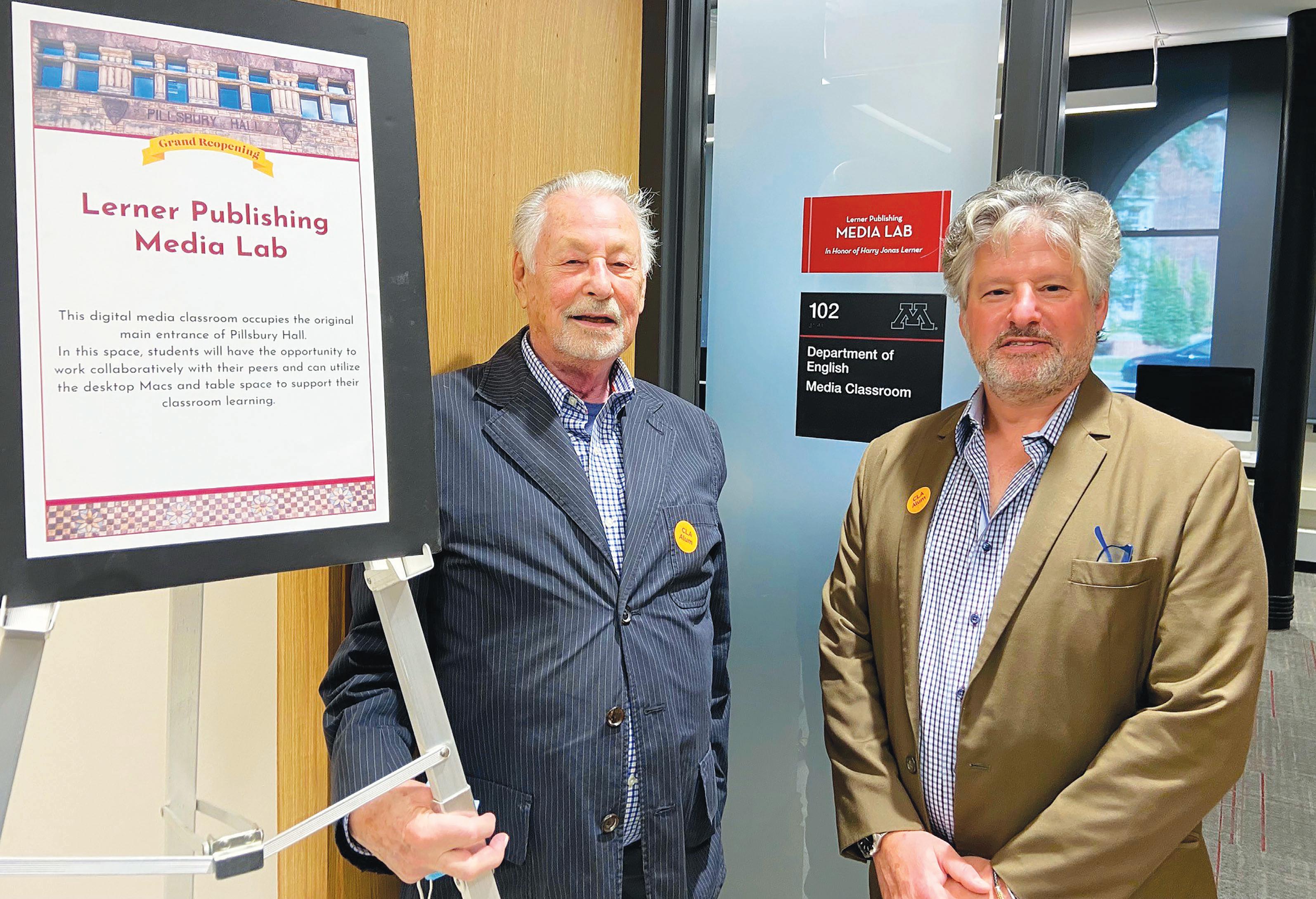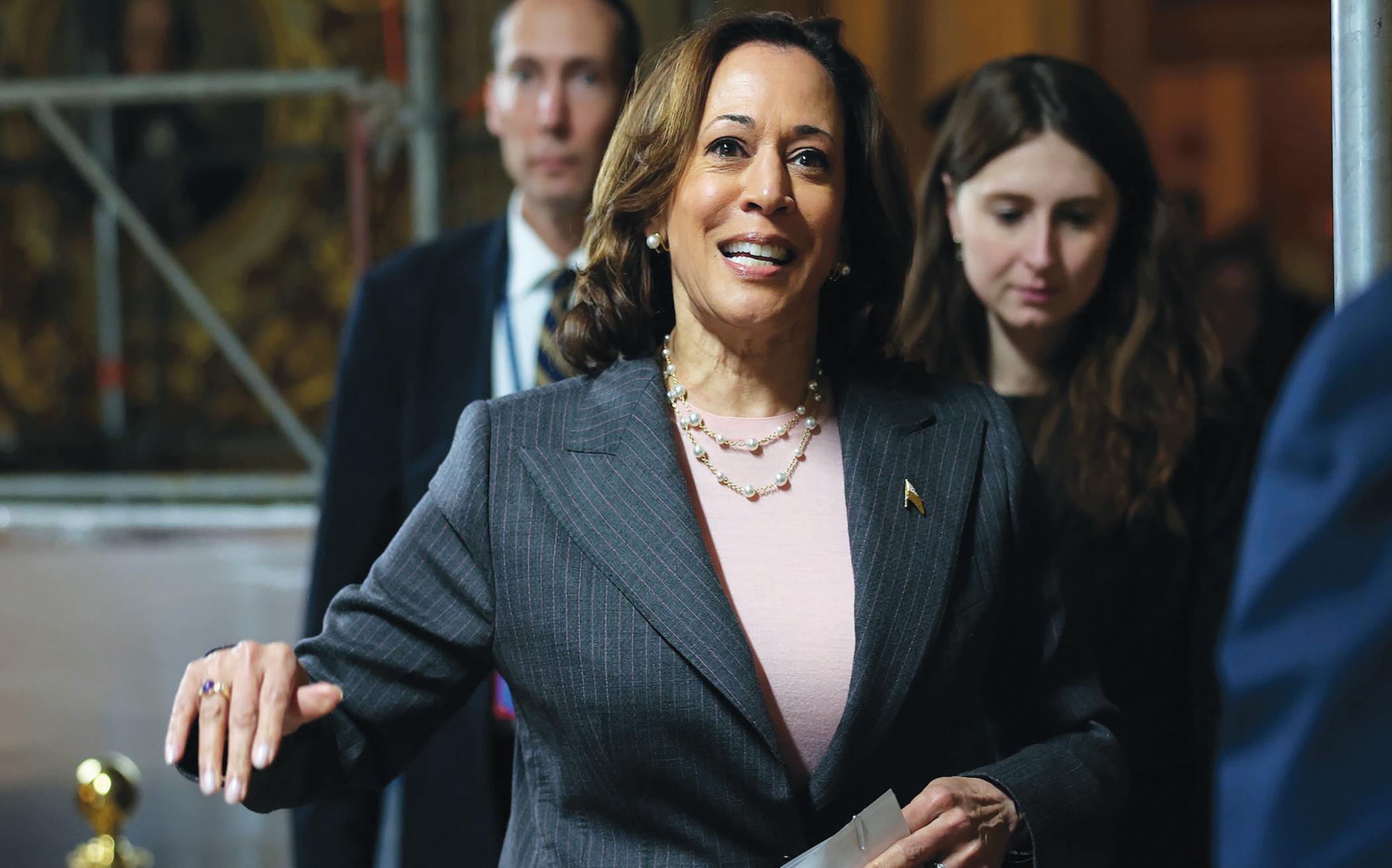
10 minute read
Harry Jonas Lerner: A legacy of activism and leadership Harry Jonas Lerner: A legacy of activism and leadership
By Susan Curnow Breedlove, a North Minneapolis historian
Harry Jonas Lerner is Chairman of Lerner Publishing Group which he founded in 1959. It is one of the largest independent and family-owned children’s book publishers with over 7,000 titles in print and with 15 imprints and divisions. The Lerner Company is recognized for the high caliber of the books it publishes and for the interests they cover in so many diverse arenas. Harry’s son, Adam, is now the CEO and publisher of this successful company started by his father 64 years ago.
Family Background
Harry Lerner’s mother and father immigrated to the United States from the Bessarabia region of Eastern Europe following a wave of Anti-Jewish pogroms (massacre of Jews). Family members lived in the Pale of Settlement, where Jewish people were contained by czarist Russia. Today, about two thirds of Bessarabia lies within modern-day Moldova, the rest in parts of Ukraine. Harry’s mother, Lena Schwartz, 16, came to the United States in 1912 with her brother, 21. They traveled to Aitkin, Minnesota where their Uncle Mendel resided and worked on the railroad. The two siblings next moved to the small town of Rhame, North Dakota. An entrepreneur, Lena traded a cow for a cream station and started her own business.
Harry’s father, Morris, was the eldest of six children. Born in Moldova, he moved to Liverpool, England and eventually to the United States. He landed at Ellis Island where he applied for land under the Homestead Act. Next it was to Minneapolis, where he supported himself by working at the West Hotel. In 1909, at age 21, he was assigned 50 acres near Ludlow, South Dakota. There, he met his wife-to-be, Lena. The family moved to Minneapolis after the birth of Harry’s sister, Miriam.
Morris and Lena had three more children, Harry being the youngest, born in 1922. They lived at 827 Oliver and 915 Morgan Avenues in North Minneapolis. They began the Morris Island Grocery on Nicollet Island in about 1921. The grocery store was open seven days a week, early mornings until 8PM Sunday through Friday, and Saturday until 10PM. The Lerners took streetcars on Plymouth Avenue or the buses on Olson Highway to the family store. In 1933 they got a liquor license, one of only two to be issued to a Minneapolis grocery at that time. Morris and Lena were active in social groups including Arbeter Ring (Workmen’s Circle, a Jewish socialist group) and Labor Zionist groups such as Poole Tzion and the Farband.
Harry’s father’s activism and union leadership is evidenced by his name being carved on the cornerstone of the former Labor Lyceum on Olson Highway. Attendees discussed issues here which became part of the platform for the DemocraticFarmers-Labor Party (DFL). The building is now La Creche, a childcare center. Morris Lerner is also commemorated on the cornerstone of a building on Plymouth Avenue that was a location of the Workman’s Circle. He passed away in 1948 at the age of 60 when Harry was 15 years old. The day-today ledger-style journal written by Morris Lerner from 19151949 is now at the University of Minnesota (U of M) in the Lerner Publishing Media Lab in Pillsbury Hall.
Harry’s mother, Lena, was a member of the Ladies Cultural League on the Northside. The group was set up in the 1930s as a fellowship for Jewish living, informing dedicated Jews while expressing themselves through social justice. Harry’s mother was both a homemaker and a working woman at the family’s Nicollet Island grocery until 1960 when a son took over. Urban renewal took that building down and the liquor license was transferred to a nephew who has East Liquor in south Minneapolis. Lena reluctantly moved from the Northside after prompted by family members concerned about racial tensions. She also noted that she missed shopping at the Jewish grocery store on Knox and Plymouth which had been a victim of the rebellion of some youth in the late 1960s. She lived to the age of 101.
Harry Lerner’s Youth Harry was a student at Hay Elementary School on Penn Avenue. While a student at Lincoln Junior High he showed some interest in printing as he was pictured in The Minneapolis Star assisting staff prepare for the school’s 25th anniversary. He helped in the family grocery store and as a budding entrepreneur sold football pins before University of Minnesota games. He also earned the privilege of free movie tickets and $1 a week by being a canopy setter, hanging from rafters to change the names of films of The Homewood Theater on Plymouth Avenue.
The Lerner family joined the congregants of Tifereth B’nai Jacob also known as The Elwood Shul on 810 Elwood Avenue North. It was founded in 1890 by fellow immigrants from the town of Filishter in Bessarabia and served the community for seventy years before merging with other synagogues and moving to St. Louis Park. Congregants of First Church of God and Christ now worship in this building.
Harry attended Talmud Torah four days a week through his Bar Mitzvah. This Hebrew school was where Northside Jewish children came together to learn their heritage. He went to Zionist summer camps in Waupaca, Wisconsin and to conferences with other teenagers in the Labor Zionist Movement. Harry was active in the Habonim whose goal was to reclaim the Holy Land as a socialist paradise.
Harry went to North Community High School, class of 1951, and began studies at the U of M. In 1953-54, at the age of 20, he traveled with a group to Israel where he studied at Hebrew University.
Publishing Begins in the Army Drafted by the U.S. Army, Harry had to curtail his education in the College of Liberal Arts at the University of Minnesota. He was classified as a linguist for the Army, as he knew some Hebrew, Arabic, and German languages. He was assigned to the clerk typist school in Fort Dix, New Jersey. Later, he was shipped to Europe, ending in Germany, where Harry’s publishing career began when he wrote the C-Plate Car and Travel Guide for servicemen and women stationed overseas that were interested in buying cars and getting travel advice.
The guide was distributed by Stars and Stripes, the U.S. military independent news source, and was sold in the Army PX stores. Fulfilling his armed service duties, Harry returned to Minnesota and resumed his studies at the University of Minnesota, earning a Bachelor of Arts Degree in International Relations in 1957. Interest in publishing was fueled by trade industry magazines and he began publishing The Sporting Goods Journal with his long- time friend and mentor Don Goldfus.
Harry’s Family Sharon Goldman and Harry met in 1960, married in 1961, and eventually moved to Plymouth, Minnesota where they had four children, named Adam, Danny, Leah, and Mia. The couple were a part of the Soviet Jewry Action Committee organized to support Jews who wanted to leave the Soviet Union. The organization grew into the Minnesota-Dakotas Action Committee for Soviet Jewry. Sharon also served as an author and illustrator for Lerner Publications. She passed away in 1982. Harry and Sandra Karon Davis met in 1985. She worked as an editor and proofreader at Lerner Publications. They were married in 1996. Son Adam and daughter Mia began working at Lerner Publishing in 1998. Mia is an author and illustrator, and Adam is now the publisher and CEO of the company. Harry serves as Chairman of the Board of Lerner and Sandy is an editor and proofreader.
The Beginnings of Lerner Publishing Group Harry began publishing children’s books collaborating with his sister-inlaw Margie who was writing children’s stories about medical topics such as chickenpox, mumps, and measles. She featured a female doctor in the books, at a time when there were few of them. The first significant award Margie received was for a book she wrote about the scientific explanation of skin color titled Red Man, White Man, African Chief. Henry began attending book fairs as a young publisher. There he noticed that textbook companies had a monopoly on what was being published. He wanted to provide alternatives.
Harry Lerner Today Mr. Lerner continues to go to the office on 241 N 1st Street every week. He has a wide circle of friends and acquaintances, both personal and professional. When asked the question: “How do you and Lerner Publishing decide what to publish?”, he responded, “I am sort of a historian. My interest and the company’s interest are in social history. Those are the kinds of books we like to publish. We look for stories that are timely and of current interest of readers.” And when probed further with the questions,
“How is it that so many are about social issues? How is it that there is such a wide range of diverse voices in your 7,000 books?” Harry replied, “I grew up on the Northside. I went to North High School. And I am a long-time DFLer.”
Lerner Publishing September 20, 2021, the Lerner Publishing Media Lab opened in Pillsbury Hall at the University of Minnesota, established to honor founder Harry Lerner. May, 2019, the city of Minneapolis officially proclaimed the month of May as Lerner Publishing Group Month in honor of its 60th anniversary.
Prestigious recent awards include a Caldecott Honor, Coretta Scott King Author and Illustrator Awards, Robert Fl Sibert Informational Book Award and honors, Sydney Taylor Book Award and honors, a Pura Belpre’ Honor, an American Indian Library Association Youth Literature Award Honor, an Asian/Pacific American Award for Literature, a Los Angeles Times Book Prize Winner, a New York Times Best Illustrated Children’s Book, and a National Book Award Finalist. In 2022 Lerner Publishing Group received 33 starred reviews from prestigious journals including Publishers Weekly, School Library Journal, Booklist, Kirkus Reviews, and others.
Lerner Publishing Group is proud to have recently hit the independent bookstores’ best-seller list with Braiding Sweetgrass for Young Adults by Robin Wall Kimmerer, adapted by Monique Gray Smith, and illustrated by Nicole Neidhardt. Harry Lerner’s Contributions, Recognitions, and Memberships
1961-Kay Sexton award in recognition of longstanding dedication and outstanding work in fostering books, reading, and literary activity in Minnesota. Kay
Sexton awards are part of the Minnesota Book Awards presented annually.
1970-Member, Board of Directors Foreign Policy Association, Minnesota
1974-Member, Minnesota Book Publications
Roundtable
1979-Delegate, White House Conference on Library and Information Services
1972-1979-Chairman, North Loop Business Association, Minneapolis 1991-1994-Children’s
Book Council, New York City
1996-Board advisor, Books for Africa
1997-Minnesota Library Association Foundation
2004-Minnesota Innovative Communicator Award, Minnesota State University
Affiliations: Jewish Historical Society of the Upper Midwest, St. Paul-Minneapolis Committee on Foreign Relations, Walker Art Center, Minneapolis Institute of Art (MIA) and the University of Minnesota Press
Lerner Family Philanthropy
The Loft; Books for Africa; The Minnesota Library Association Foundation; Hennepin County Public Library; University of Minnesota libraries including the Kerlan Collection; PJ Library Minneapolis; scholarships including the Vaunda Micheaux Nelson Scholarship for Writers of Color at Hamline University. Thank you to Natalie Hart, Sumner librarian, and Joni Sussman, publisher of Karben Publishing, a division of Lerner Publishing, for assisting in proofreading and editing this document. For additional information please contact Susan Breedlove at smcbreedlove@ gmail.com or call at 612-5888470
The following resources about the history of Northside Minneapolis are available through libraries and/or online: Tenacity Well
Directed: The Inside Story of How a Publishing House Was
Created and Became a Sleeping Giant in Its Field-Well, Not Exactly (40th anniversary book) by Harry Lerner, Lerner Publishing Group, copyright 2009
Cornerstones: A History of North Minneapolis, University of Minnesota and TPT, copyright 2011. (Call or e-mail TPT for purchase or viewing times)
The Heart of Bassett Place: The story of an African American settlement house and the woman who made it possible, South Hill Films, copyright 1999 We Knew Who We Were: Memories of the Minneapolis Jewish North Side, The Jewish Historical Society of the Upper Midwest and The North Side Committee, copyright 2008. Jewish Community of North Minneapolis, Rhoda Lewin, Arcadia Publishing Company, copyright 2001


By Joshua Holzer Assistant Professor of Political Science, Westminster College
On Jan. 20, 2021, Kamala
Harris became the first African American, the first person of South Asian descent and the firstwoman to serve as vice president of the United States.
More recently, she made history again by casting her 31st tie-breaking vote in the Senate, matching only one other vice president’s record for such votes. John C. Calhoun, who was vice president from 1825 to 1832, needed all eight years of his term to reach that number. In contrast, Harris has only been in office for two and a half years.
If her tie-breaking continues, Harris could end up as one of the most consequential vice presidents in history, casting the deciding votes on several laws, judicial nominations and spending plans. However, this distinction says more about the Senate than the amount of power the vice president actually wields.

The ‘most insignificant’ office?
The role of vice president is only mentioned in the U.S. Constitution a handful of times.
Article I, Section 3 says that the vice president “shall be President of the Senate but shall have no Vote” except in the event of a tie. Historically, ties have been rare. Since 1789, only 299 tie-breaking votes have been cast, and 12 vice presidents, including current President Joe Biden, never cast a single one.
The beginning of Article II, Section 1 explains how vice presidents are elected, which was later revised by the 12th Amendment. The end of that section states that presidential power “shall devolve on the Vice President” in the event of the president’s “Death, Resignation, or Inability to discharge the Powers and Duties of the said Office.”
As written, it is unclear whether this meant that a vice president became the new president or was simply serving in an acting capacity. This was later clarified with the passage of the 25th Amendment, which states that “the Vice President shall become President.” The 25th Amendment also outlines how to fill a vacancy in the vice presidency, and it provides a mechanism for the vice president to serve temporarily as president if a president becomes “unable to discharge the powers and duties of his office.”
Finally, Article II, Section 4 states that vice presidents, like presidents, can be “removed from Office on Impeachment for, and Conviction of, Treason, Bribery, or other high
Crimes and Misdemeanors.”
So, other than staying out of trouble to avoid impeachment and waiting around to serve as – or replace – the president, vice presidents are really only obligated to occasionally cast a tiebreaking vote in the Senate. This means that the great majority of the time, vice presidents have no real job to do.
John Adams, the first U.S. vice president, once complained to his wife that the vice presidency was “the most insignificant Office that ever the Invention of Man contrived or his Imagination conceived.”
However, not all have been upset about such inactivity. Woodrow Wilson’s vice president, Thomas Marshall, quipped after he retired: “I don’t want to work … [but] I wouldn’t mind being Vice President again.”






